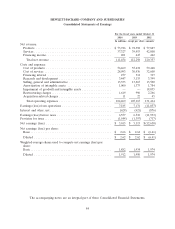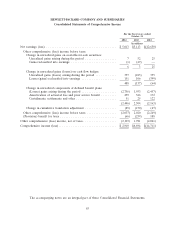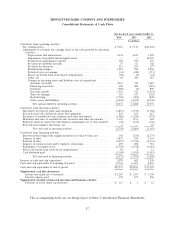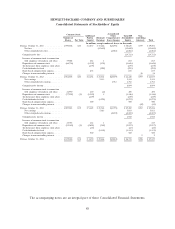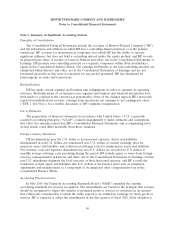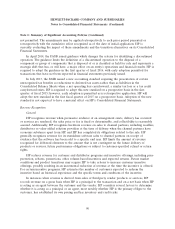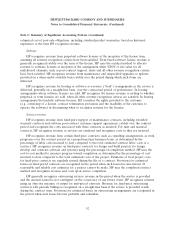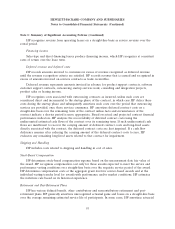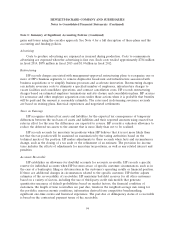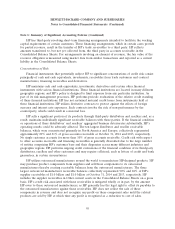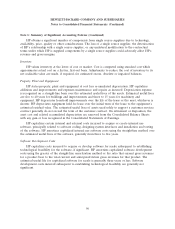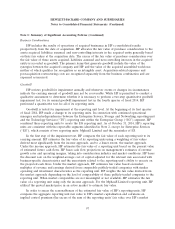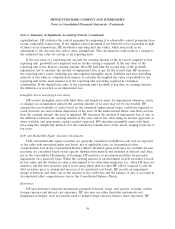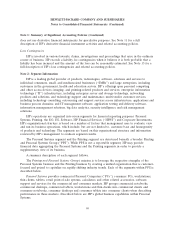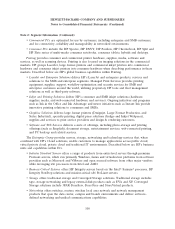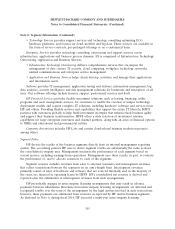HP 2014 Annual Report Download - page 99
Download and view the complete annual report
Please find page 99 of the 2014 HP annual report below. You can navigate through the pages in the report by either clicking on the pages listed below, or by using the keyword search tool below to find specific information within the annual report.HEWLETT-PACKARD COMPANY AND SUBSIDIARIES
Notes to Consolidated Financial Statements (Continued)
Note 1: Summary of Significant Accounting Policies (Continued)
HP reports revenue net of any taxes collected from customers and remitted to government
authorities, with the collected taxes recorded as current liabilities until remitted to the relevant
government authority.
Multiple element arrangements
When a sales arrangement contains multiple elements or deliverables, such as hardware and
software products, and/or services, HP allocates revenue to each element based on a selling price
hierarchy. The selling price for a deliverable is based on its vendor specific objective evidence
(‘‘VSOE’’) of selling price, if available, third party evidence (‘‘TPE’’) if VSOE of selling price is not
available, or estimated selling price (‘‘ESP’’) if neither VSOE of selling price nor TPE is available. HP
establishes VSOE of selling price using the price charged for a deliverable when sold separately and, in
rare instances, using the price established by management having the relevant authority. HP establishes
TPE of selling price by evaluating largely similar and interchangeable competitor products or services in
standalone sales to similarly situated customers. HP establishes ESP based on management judgment
considering internal factors such as margin objectives, pricing practices and controls, customer segment
pricing strategies and the product life cycle. Consideration is also given to market conditions, such as
competitor pricing strategies and technology life cycles. In arrangements with multiple elements, HP
allocates the transaction price to the individual units of accounting at inception of the arrangement
based on their relative selling price.
In multiple element arrangements that include software that is more-than-incidental, HP allocates
the transaction price to the individual units of accounting for the non-software deliverables and to the
software deliverables as a group using the relative selling price of each of the deliverables in the
arrangement based on the selling price hierarchy. If the arrangement contains more than one software
deliverable, the transaction price allocated to the group of software deliverables is then allocated to
each component software deliverable.
HP evaluates each deliverable in an arrangement to determine whether it represents a separate
unit of accounting. A deliverable constitutes a separate unit of accounting when it has standalone value
to the customer. For elements with no standalone value, HP recognizes revenue consistent with the
pattern of the associated deliverables. If the arrangement includes a customer-negotiated refund or
return right or other contingency relative to the delivered items, and the delivery and performance of
the undelivered items is considered probable and substantially within HP’s control, the delivered
element constitutes a separate unit of accounting. In arrangements with combined units of accounting,
changes in the allocation of the transaction price between elements may impact the timing of revenue
recognition for the contract but will not change the total revenue recognized for the contract.
Product revenue
Hardware
Under HP’s standard terms and conditions of sale, HP transfers title and risk of loss to the
customer at the time product is delivered to the customer and recognizes revenue accordingly, unless
customer acceptance is uncertain or significant obligations to the customer remain. HP reduces revenue
for estimated customer returns, price protection, rebates and other programs offered under sales
agreements established by HP with its distributors and resellers. HP records revenue from the sale of
equipment under sales-type leases as product revenue at the inception of the lease. HP accrues the
91





